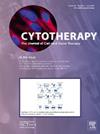FTY720P-treated macrophages in PEG-4MAL hydrogels promote oral wound healing
IF 3.7
3区 医学
Q2 BIOTECHNOLOGY & APPLIED MICROBIOLOGY
引用次数: 0
Abstract
Background aims
Oral wound healing involves hemostasis, inflammation, proliferation and tissue remodeling. The oral cavity is a complex wound healing environment because of the presence of saliva, a high bacterial burden and ongoing physical trauma from eating. The inflammatory component of wound healing balances the polarization of macrophages in healing tissues between M1 inflammatory macrophages and M2 anti-inflammatory macrophages. M2 macrophages secrete anti-inflammatory and pro-regenerative cytokines and chemokines, which aid wound healing. Fingolimod, or FTY720, a Food and Drug Administration–approved sphingosine-1-phosphate modulator, has been implicated in inducing the polarization of macrophages to the M2 phenotype. In this study, we investigated whether macrophage pre-treatment with phosphorylated FTY720 (FTY720P), the bioactive form of the drug, in a PEG-4MAL hydrogel promotes improved oral wound healing in a critically sized oral mucosal defect model.
Methods and Results
Using cytokine dot blots and Luminex cytokine assays (MilliporeSigma, Burlington, MA, USA), FTY720P-treated murine RAW 264.7 and human THP1-differentiated macrophages in PEG-4MAL hydrogels secreted chemokines and cytokines known to regulate inflammation (e.g., interleukin [IL] 4, IL-13) and induce M2 macrophage polarization (e.g., CCL6, CCL22), leukocyte migration (e.g., CXCL2, CCL2, CCL12, CCL22), angiogenesis (e.g., vascular endothelial growth factor) and epithelialization (e.g., IL-1, IL-17, IL-22). In vitro, FTY720P-treated cells induced chemotaxis of macrophages and fibroblasts in Transwell assays (Corning, Corning, NY, USA) and oral epithelial scratch wound closure. In a murine oronasal fistula (ONF) model of oral wound healing, the local application of FTY720P-treated macrophages in PEG-4MAL hydrogels significantly increased wound closure (75% closure) relative to non-treated cells (40% closure) and blank hydrogel controls (25% closure) (P < 0.0001). Flow cytometry of mouse palatal tissue showed that application of FTY720P-treated macrophage hydrogels to ONFs significantly increased day 7 percentage of M1 and M2 macrophages, mesenchymal stromal cells and CD19+ B cells. Significantly fewer neutrophils, monocytes, CD4+/CD8+ T cells and endothelial cells were observed in the FTY720P-treated macrophage defects, suggesting that FTY720P-treated macrophages in hydrogels promote oral wound healing via suppression of granulation and resolution of inflammation and promotion of tissue maturation.
Conclusions
Our data provide new insights into the use of potential FTY720P-treated macrophage therapies for oral wound healing and have clinical implications for cleft palate and oral surgery.
fty720p处理的巨噬细胞在PEG-4MAL水凝胶中促进口腔伤口愈合。
背景目的:口腔创面愈合包括止血、炎症、增殖和组织重塑。口腔是一个复杂的伤口愈合环境,因为唾液的存在,高细菌负担和持续的进食造成的身体创伤。伤口愈合的炎症成分平衡了愈合组织中巨噬细胞在M1炎性巨噬细胞和M2抗炎巨噬细胞之间的极化。M2巨噬细胞分泌抗炎和促再生细胞因子和趋化因子,有助于伤口愈合。Fingolimod,或FTY720,是美国食品和药物管理局批准的鞘氨醇-1-磷酸调节剂,与诱导巨噬细胞向M2表型极化有关。在这项研究中,我们研究了在PEG-4MAL水凝胶中使用磷酸化FTY720 (FTY720P)(该药物的生物活性形式)预处理巨噬细胞是否能促进临界尺寸口腔粘膜缺损模型的口腔伤口愈合。方法与结果:使用细胞因子斑点斑点和Luminex细胞因子测定(MilliporeSigma, Burlington, MA, USA), fty720p处理的小鼠RAW 264.7和人thp1分化的巨噬细胞在PEG-4MAL水凝胶中分泌出已知的调节炎症的趋化因子和细胞因子(例如,白细胞介素[IL] 4, IL-13),诱导M2巨噬细胞极化(例如,CCL6, CCL22),白细胞迁移(例如,CXCL2, CCL2, CCL12, CCL22),血管生成(例如,血管内皮生长因子)和上皮化(例如,IL-1, IL-17,il - 22生成)。在体外,fty720p处理的细胞诱导巨噬细胞和成纤维细胞的趋化性,在Transwell实验(Corning, Corning, NY, USA)和口腔上皮划伤愈合中。在小鼠口鼻瘘(ONF)口腔创面愈合模型中,局部应用fty720p处理的巨噬细胞在PEG-4MAL水凝胶中,相对于未处理的细胞(40%闭合)和空白水凝胶对照组(25%闭合),显著增加创面闭合(75%闭合)(P < 0.0001)。小鼠腭组织流式细胞术显示,经fty720p处理的巨噬细胞水凝胶作用于ONFs后,第7天M1和M2巨噬细胞、间充质基质细胞和CD19+ B细胞的百分比显著增加。在fty720p处理的巨噬细胞缺陷中,中性粒细胞、单核细胞、CD4+/CD8+ T细胞和内皮细胞明显减少,表明水凝胶中fty720p处理的巨噬细胞通过抑制肉芽形成、消除炎症和促进组织成熟来促进口腔伤口愈合。结论:我们的数据为使用fty720p治疗的巨噬细胞治疗口腔伤口愈合提供了新的见解,并对腭裂和口腔手术具有临床意义。
本文章由计算机程序翻译,如有差异,请以英文原文为准。
求助全文
约1分钟内获得全文
求助全文
来源期刊

Cytotherapy
医学-生物工程与应用微生物
CiteScore
6.30
自引率
4.40%
发文量
683
审稿时长
49 days
期刊介绍:
The journal brings readers the latest developments in the fast moving field of cellular therapy in man. This includes cell therapy for cancer, immune disorders, inherited diseases, tissue repair and regenerative medicine. The journal covers the science, translational development and treatment with variety of cell types including hematopoietic stem cells, immune cells (dendritic cells, NK, cells, T cells, antigen presenting cells) mesenchymal stromal cells, adipose cells, nerve, muscle, vascular and endothelial cells, and induced pluripotential stem cells. We also welcome manuscripts on subcellular derivatives such as exosomes. A specific focus is on translational research that brings cell therapy to the clinic. Cytotherapy publishes original papers, reviews, position papers editorials, commentaries and letters to the editor. We welcome "Protocols in Cytotherapy" bringing standard operating procedure for production specific cell types for clinical use within the reach of the readership.
 求助内容:
求助内容: 应助结果提醒方式:
应助结果提醒方式:


